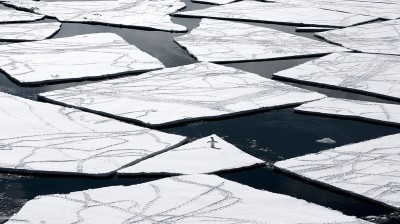Global Sea Ice Back to 1979 Levels … Ice Has “Moved” from Arctic to Antarctic

New charts from the University of Illinois’ Department of Atmospheric Sciences (based upon data provided by NOAA’s National Center for Environmental Prediction) show something odd.
Specifically, the new data shows that global sea ice is back to 1979 levels … but that that sea ice has “moved” from the Arctic to the Antarctic (in the sense that sea ice has increased in the Antarctic but decreased in the Arctic):
What does this mean?
We spoke with the head of Stanford University’s Atmosphere and Energy Program (Mark Jacobson) last year, and asked him to explain. Here’s what he said …
WASHINGTON’S BLOG: [Why is] the Arctic is experiencing more ice loss than the Antarctic … ?
JACOBSON: The Arctic is closer to the melting point, so you get feedbacks because – when that ice melts – then you’re uncovering the dark surface below.
The Antarctic is harder to melt, so – even if you raise the temperature – it doesn’t change the albedo [the ability to reflect sunlight]. So there’s not this positive feedback.
WASHINGTON’S BLOG: Part of the debate between global warming believers and global warming skeptics is that Antarctic ice has increased during certain recent years recently.
Is that the explanation … that it doesn’t have the “warming feedback” you mentioned?
JACOBSON: There are two things operating. First, when you have global warming, you have a lot more water vapor in the air. And – in the polar regions – that water precipitates out as ice, if you’re at freezing temperatures. So if you’re not melting the ice, then you expect an accumulation with global warming.
You’d normally get an accumulation of ice at the North Pole. But since there’s a lot of melting there (because it’s closer to the melting point than the Antarctic), and the ice is very thin – it’s only one to three meters thick – compared to the Antarctic glaciers that are three kilometers thick.
So you’ve got this accumulation at both poles, but the accumulation in the Arctic is melting. Because you’re evaporating all this water from the oceans, that’s got to go somewhere, and once you get to subfreezing temperatures, it’s going to deposit it as ice or snow at the Antarctic.
[Indeed, the mean summer temperature at the North Pole is right at the melting point (32 degrees Fahrenheit). In sharp contrast, the mean summer temperature at the South Pole is negative 18 degrees Fahrenheit. So any extra temperature in the Arctic could melt a whole lot of ice during the summer; but you’d need almost 50 degree higher summer temperatures in the Antarctic to get up to the melting point.]
Postscript: Do you think Dr. Jacobson is right? Or do you think something else is going on?




